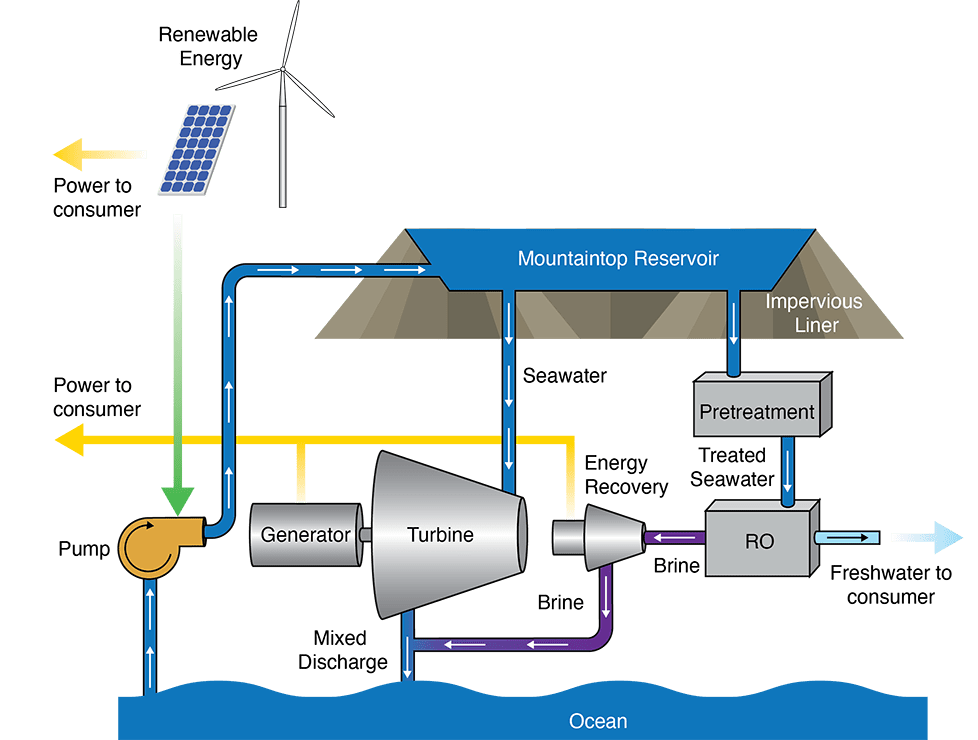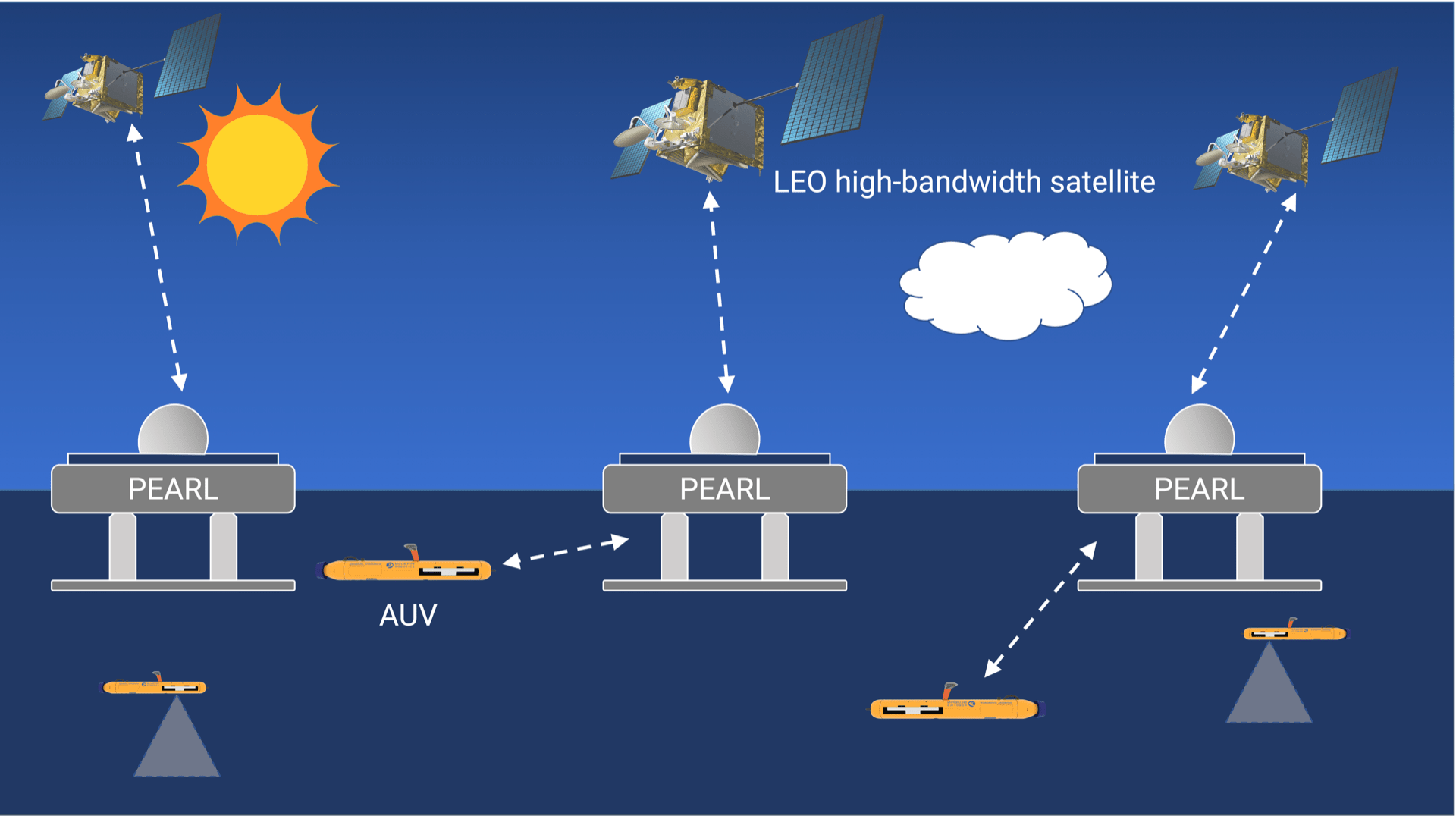Systems Engineering
With a push to utilize more of our world’s oceans to meet our water, energy, and food needs, the SEA Lab is studying how to design new ocean systems with a focus on sustainability and global security. We utilize techniques of multidisciplinary design optimization, coupled with agent-based modeling techniques to optimize systems on the individual and fleet/farm level.
Integrated Pumped Hydro and Reverse Osmosis Systems (IPHROS)
With the ideal head height for pumped storage hydropower and reverse osmosis both at approximately 500-700 m, co-location of these systems could reduce capital investments such as pump costs while also solving brine disposal issues for desalination. In the SEA Lab, we are developing the Integrated Pumped Hydro Reverse Osmosis system (IPHROS), to meet the energy and water needs of coastal communities around the world.
Relevant Publications:
- M. Haefner and M. N. Haji, “Integrated Pumped Hydro Reverse Osmosis System Optimization Featuring Surrogate Model Development in Reverse Osmosis Modeling,” under review.
- M. Haefner, and M. N. Haji, “Integrated Pumped Hydro Reverse Osmosis System Optimization with Enhanced Reverse Osmosis Modeling,” International Conference on Applied Energy 2021, Virtual, November 29-December 2, 2021. https://www.energy-proceedings.org/wp-content/uploads/icae2021/1643326773.pdf
- A. H. Slocum, M. N. Haji, A. Z. Trimble, M. Ferrera, and S. J. Ghaemsaidi, “Integrated Pumped Hydro Reverse Osmosis Systems,” Sustainable Energy Technologies and Assessments, 18, 80-99, 2016. https://doi.org/10.1016/j.seta.2016.09.003 – Featured on MIT News


Platform for Expanding AUV exploRation to Longer ranges (PEARL)
Ongoing in the SEA Lab, in partnership with the Engineering Systems Laboratory at the Massachusetts Institute of Technology, is the development of an autonomous floating platform as a servicing station for autonomous underwater vehicles (AUVs) that is capable of leveraging new generation high-bandwidth low-Earth orbit (LEO) satellite constellations to relay data from AUVs back to shore in near-real-time, while harnessing solar energy to recharge AUVs at sea. Known as the Platform for Expanding AUV exploRation to Longer ranges (PEARL), the system can reduce latency of data gathered by AUVs, reduce operational costs associated with deploying and retrieving AUVs, and increase the range and endurance of AUVs. Additionally, our group is use agent-based modeling to study how the simultaneous operation of the system-of-systems of the underwater (AUVs), surface (PEARL) and space (LEO satellite constellations) assets can be scheduled to optimize the productivity of AUVs at the fleet level.
Relevant Publications:
- E. Rolland, M. N. Haji, and O. L. de Weck, “Autonomous control of a prototype solar-powered offshore autonomous underwater vehicle servicing platform via a low-cost embedded architecture,” Journal of Field Robotics, 1-20, 2023. https://doi.org/10.1002/rob.22155
- M. N. Haji, J. Tran, L. Woodcock, and O. L. de Weck, “Design of a Prototype Renewably-powered Offshore AUV Servicing Platform,” 41st International Conference on Ocean, Offshore & Arctic Engineering 2022, Hamburg, Germany, June 5-10, 2022. https://doi.org/10.1115/OMAE2022-80349
- E. Rolland, M. N. Haji, and O. L. de Weck, “Autonomous Control of a Solar-Powered Offshore AUV Servicing Platform Using MOOS-IvP,” OCEANS’21, Hybrid, San Diego, CA, September 21-23, 2021. https://doi.org/10.23919/OCEANS44145.2021.9705966
- M. N. Haji, J. Tran, J. Norheim, and O. L. de Weck “Design and Testing of AUV Docking Modules for a Renewably Powered Offshore AUV Servicing Platform,” 39th International Conference on Ocean, Offshore & Arctic Engineering 2020, Virtual, August 3-7, 2020. https://doi.org/10.1115/OMAE2020-18982
Systems Engineering
With a push to utilize more of our world’s oceans to meet our water, energy, and food needs, the SEA Lab is studying how to design new ocean systems with a focus on sustainability and global security. We utilize techniques of multidisciplinary design optimization, coupled with agent-based modeling techniques to optimize systems on the individual and fleet/farm level.
Integrated Pumped Hydro and Reverse Osmosis Systems (IPHROS)
With the ideal head height for pumped storage hydropower and reverse osmosis both at approximately 500-700 m, co-location of these systems could reduce capital investments such as pump costs while also solving brine disposal issues for desalination. In the SEA Lab, we are developing the Integrated Pumped Hydro Reverse Osmosis system (IPHROS), to meet the energy and water needs of coastal communities around the world.
Relevant Publications:
- M. Haefner and M. N. Haji, “Integrated Pumped Hydro Reverse Osmosis System Optimization Featuring Surrogate Model Development in Reverse Osmosis Modeling,” under review.
- M. Haefner, and M. N. Haji, “Integrated Pumped Hydro Reverse Osmosis System Optimization with Enhanced Reverse Osmosis Modeling,” International Conference on Applied Energy 2021, Virtual, November 29-December 2, 2021. https://www.energy-proceedings.org/wp-content/uploads/icae2021/1643326773.pdf
- A. H. Slocum, M. N. Haji, A. Z. Trimble, M. Ferrera, and S. J. Ghaemsaidi, “Integrated Pumped Hydro Reverse Osmosis Systems,” Sustainable Energy Technologies and Assessments, 18, 80-99, 2016. https://doi.org/10.1016/j.seta.2016.09.003 – Featured on MIT News


Platform for Expanding AUV exploRation to Longer ranges (PEARL)
Ongoing in the SEA Lab, in partnership with the Engineering Systems Laboratory at the Massachusetts Institute of Technology, is the development of an autonomous floating platform as a servicing station for autonomous underwater vehicles (AUVs) that is capable of leveraging new generation high-bandwidth low-Earth orbit (LEO) satellite constellations to relay data from AUVs back to shore in near-real-time, while harnessing solar energy to recharge AUVs at sea. Known as the Platform for Expanding AUV exploRation to Longer ranges (PEARL), the system can reduce latency of data gathered by AUVs, reduce operational costs associated with deploying and retrieving AUVs, and increase the range and endurance of AUVs. Additionally, our group is use agent-based modeling to study how the simultaneous operation of the system-of-systems of the underwater (AUVs), surface (PEARL) and space (LEO satellite constellations) assets can be scheduled to optimize the productivity of AUVs at the fleet level.
Relevant Publications:
- E. Rolland, M. N. Haji, and O. L. de Weck, “Autonomous control of a prototype solar-powered offshore autonomous underwater vehicle servicing platform via a low-cost embedded architecture,” Journal of Field Robotics, 1-20, 2023. https://doi.org/10.1002/rob.22155
- M. N. Haji, J. Tran, L. Woodcock, and O. L. de Weck, “Design of a Prototype Renewably-powered Offshore AUV Servicing Platform,” 41st International Conference on Ocean, Offshore & Arctic Engineering 2022, Hamburg, Germany, June 5-10, 2022. https://doi.org/10.1115/OMAE2022-80349
- E. Rolland, M. N. Haji, and O. L. de Weck, “Autonomous Control of a Solar-Powered Offshore AUV Servicing Platform Using MOOS-IvP,” OCEANS’21, Hybrid, San Diego, CA, September 21-23, 2021. https://doi.org/10.23919/OCEANS44145.2021.9705966
- M. N. Haji, J. Tran, J. Norheim, and O. L. de Weck “Design and Testing of AUV Docking Modules for a Renewably Powered Offshore AUV Servicing Platform,” 39th International Conference on Ocean, Offshore & Arctic Engineering 2020, Virtual, August 3-7, 2020. https://doi.org/10.1115/OMAE2020-18982
